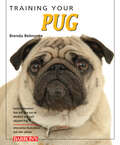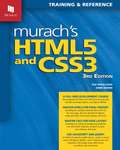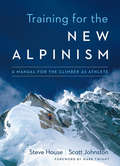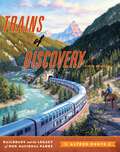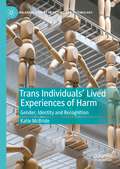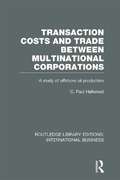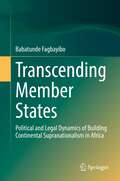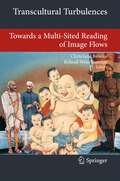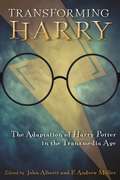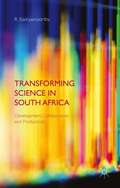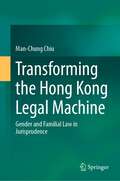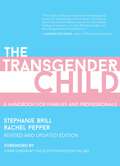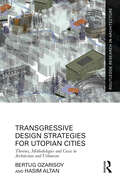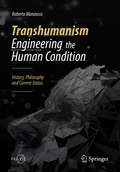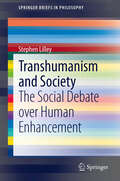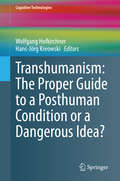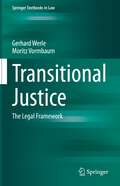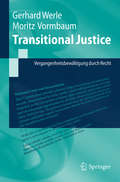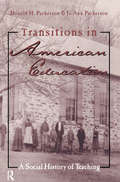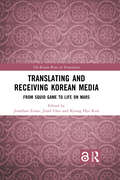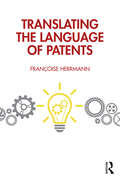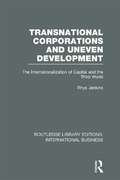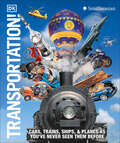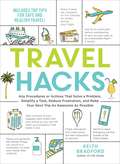- Table View
- List View
Training Your Pug (Training Your Dog Series)
by Brenda BelmonteIt's well known that each canine breed has its own traits, but when acquiring a new pet dog, many inexperienced owners mistakenly assume that the "one-size-fits-all" approach is adequate for purposes of dog training. This new title in B.E.S. Training Your Dog pet care series focuses on the distinctive traits of the Pug. Dog owners learn humane but effective methods of housebreaking and paper training, obedience training, teaching the dog to respond to verbal commands, walk on a leash, and more. All books in the Training Your Dog series are filled with instructive, step-by-step color photos that demonstrate training methods.
Training and Reference: Murach's HTML5 and CSS3 (3rd Edition)
by Zak Ruvalcaba Anne BoehmSo whether you're a web designer, a JavaScript programmer, a server-side programmer, or a rookie, this book delivers the HTML/CSS coding skills you need today. It begins with an 8-chapter hands-on course that teaches you HTML5 and CSS3 from scratch, showing you how you can't use one without the other nowadays. This quick-start course ends with a chapter that teaches you how to use Responsive Web Design (RWD) so your pages will look good and work right on any screen, from phone to tablet to desktop and beyond. In fact, you ll learn more about RWD in this one chapter than you can in many full books on the subject! After that, you can go on to any other chapter in the book to learn new skills whenever you need them. For example, you can learn how to enhance a site with audio and video clips, forms with HTML5 data validation, or CSS3 transitions and animations. You can see how to use JavaScript and jQuery to add features like accordions, tabs, and slide shows to a page, or to create a mobile site when a responsive site is impractical. You can learn the principles of web design, as well as how to deploy your finished sites. And no matter what, you can use the book as a time-saving reference whenever you have a question about HTML and CSS.
Training for the New Alpinism
by Steve House Scott Johnston Mark TwightIn Training for the New Alpinism, Steve House, world-class climber and Patagonia ambassador, and Scott Johnston, coach of U.S. National Champions and World Cup Nordic Skiers, translate training theory into practice to allow you to coach yourself to any mountaineering goal. Applying training practices from other endurance sports, House and Johnston demonstrate that following a carefully designed regimen is as effective for alpinism as it is for any other endurance sport and leads to better performance. They deliver detailed instruction on how to plan and execute training tailored to your individual circumstances. Whether you work as a banker or a mountain guide, live in the city or the country, are an ice climber, a mountaineer heading to Denali, or a veteran of 8,000-meter peaks, your understanding of how to achieve your goals grows exponentially as you work with this book. Chapters cover endurance and strength training theory and methodology, application and planning, nutrition, altitude, mental fitness, and assessing your goals and your strengths. Chapters are augmented with inspiring essays by world-renowned climbers, including Ueli Steck, Mark Twight, Peter Habeler, Voytek Kurtyka, and Will Gadd. Filled with photos, graphs, and illustrations.
Trains of Discovery: Railroads and the Legacy of Our National Parks
by Alfred RunteA thoroughly revised and expanded successor to Alfred Runte&’s Trains of Discovery: Western Railroads and the National Parks, the new edition now includes protected landscapes and historical sites east of the Mississippi made possible or influenced by railroads: the Hudson River Valley; Delaware Water Gap; Harpers Ferry; Indiana Dunes; Gettysburg; Steamtown; and Shenandoah, Great Smoky Mountains, and Acadia National Parks. Illustrated with paintings, posters, photographs, and artifacts from major libraries and public archives, as well as America&’s railroads and the author&’s private collection, this book is a sight to behold as well as a wonderful, nostalgic armchair read.
Trans Individuals Lived Experiences of Harm: Gender, Identity and Recognition (Palgrave Studies in Victims and Victimology)
by Katie McBrideThis book explores how neoliberal consumer capitalist ideals of meritocracy, competitive individualism, and responsibilisation have shaped trans people’s subjectivity and lived experiences of harm. The book critiques the adequacy of legal constructs of hate crime to acknowledge the social harms experienced. The deep ethnographic data illuminates a variety of social harms that result from the failure of social structures and systems to acknowledge gender identities beyond the binary. The book offers a historically grounded theorisation of anti-trans sentiment to produce a persuasive argument for understanding the harms of hate as recognitive harms. In this sense, the book opens up a path to theorizing the empirically documented emotional and psychological harms of both transphobia and transnormative ideals, as rooted in a binary gender order that has been invigorated by the hyper individualism and competitiveness of capitalist neoliberalism.
Transaction Costs & Trade Between Multinational Corporations: A Study Of Offshore Oil Production (Routledge Library Editions: International Business)
by C Paul HallwoodUntil this book was published little had appeared on the matter of the organization of production in oil gathering. This book: Describes the global offshore oil supply industry and its features on one of the world’s major offshore oil services bases Draws on the theory of the multinational corporation to explain why buyers and sellers should have internationalized themselves into a symbiotic relationship Discusses the preference of the oil companies for vertical disintegration Explains the transaction cost paradigm Integrates the largely American literature on the transaction cost paradigm with the literature on the multinational corporation (which is largely British).
Transcending Member States: Political and Legal Dynamics of Building Continental Supranationalism in Africa
by Babatunde FagbayiboThis book explores innovative and context-driven political and legal policy measures designed to expand the powers of the African Union (AU) in order to meaningfully drive the continental integration process. In this regard, the book addresses issues of context, political will, and innovative and inclusive approaches as essential elements that must be considered. Africa is currently experiencing one of the most critical phases of its integrative development. Since 2015, there have been increasing efforts to develop policies and practices that grant the AU broader powers to coordinate and create binding rules regarding the regional integration process. In other words, these processes seek to endow the AU with supranational powers like those exercised by the European Union, which, despite its internal problems, remains the most successful experiment in supranationalism in the world. This has included the decision to finance the AU through a 0.2% tax on eligible imports into member states; the decision to reduce the number of AU Commission portfolios from eight to six; the adoption and entry into force of the much touted Agreement establishing the African Continental Free Trade Area; the adoption of the Protocol to the Treaty Establishing the African Economic Community Relating to Free Movement of Persons, Right to Residence and Right of Establishment; and the adoption of the AU Agenda 2063 policy framework in 2015. How these processes will change the direction of regional integration in Africa, the book argues, largely depends on the existence of quality-driven institutions.
Transcultural Turbulences
by Roland Wenzlhuemer Christiane BrosiusToday, hardly anything moves as fast across the globe as images and media. This fact opens new avenues to explore social and cultural change, but also poses new theoretical challenges of how to grasp and better understand these changes and flows. Moreover, such movements across geophysical and cultural borders have a historical depth that enables us to explore globalisation and localisation in new ways. Transculturality is still a relatively new field of research in the Humanities through which we sharpen our competence and 'literacy' to come to terms with the complexity of globalised cultures. This volume ventures into new domains of research on the transculturality of images and addresses the need to develop new or modify established often ethno- and Eurocentric interpretations of what happens when images travel. It does so by bringing together cutting-edge research from fields such as art history, cultural anthropology, colonial history, Islamic studies, religious studies and literary criticism.
Transforming Barcelona: The Renewal of a European Metropolis
by Tim MarshallThis unique book, written by local experts in the city, deals with the transformation of Barcelona during the last twenty years. Barcelona has been held up as a model of urban planning and economic regeneration amongst built environment professionals. The redesign of square parks and streets throughout the city in the 1980s first attracted attention and praise and then the 1992 Olympics hosted in the city raised international awareness. The city received many awards and accolades including a Gold Medal from the RIBA. The selection of writings is well illustrated throughout with maps, drawings and photographs and will be of interest to architects, planners and urban designers as well as those interested in the social and economic impacts of regeneration.
Transforming Harry: The Adaptation of Harry Potter in the Transmedia Age (Contemporary Approaches to Film and Media Series)
by Kelly Turner John Alberti Vera Cuntz-Leng P. Andrew Miller Andrew Howe Cassandra Bausman Maria Dicieanu Katharine McCain Michelle Markey Butler Liza Potts Emily DallaireTransforming Harry: The Adaptation of Harry Potter in the Transmedia Ageis an edited volume of eight essays that look at how the cinematic versions of the seven Harry Potter novels represent an unprecedented cultural event in the history of cinematic adaptation. The movie version of the first Harry Potter book, Harry Potter and the Sorcerer’s Stone, premiered in 2001, in between publication of the fourth and fifth books of this global literary phenomenon. As a result, the production and reception of both novel and movie series became intertwined with one another, creating a fanbase who accessed the series first through the books, first through the movies, and in various other combinations. John Alberti and P. Andrew Miller have gathered scholars to explore and examine the cultural, political, aesthetic, and pedagogical dimensions of this pop culture phenomenon and how it has changed the reception of both the films and books. Divided into two sections, the volume addresses both the fidelity of adaptation and the transmedia adaptations that have evolved around the creation of the books and movies. In her essay, Vera Cuntz-Leng draws on feminist film theory to explore the gaze politics and male objectification operating in the Harry Potter movies. Cassandra Bausman contends that screenwriter Steve Klove’s revision of the end of the film version of Deathly Hallows, Part II offers a more politically and ethically satisfying conclusion to the Harry Potter saga than the ending of the Rowling novel. Michelle Markey Butler’s "Harry Potter and the Surprising Venue of Literary Critiques" argues that the fan-generated memes work as a kind of popular literary analysis in three particular areas: the roles of female characters, the comparative analysis of books and films, and the comparative analysis of the Harry Potter series with other works of fantasy. While the primary focus of the collection is an academic audience, it will appeal to a broad range of readers. Within the academic community, Transforming Harry will be of interest to scholars and teachers in a number of disciplines, including film and media studies and English. Beyond the classroom, the Harry Potter series clearly enjoys a large and devoted global fan community, and this collection will be of interest to serious fans.
Transforming Science in South Africa
by R. SooryamoorthyThis book is essential for anyone interested in knowing how science works nationally and internationally in the contemporary world. It offers a comprehensive analysis of scientific collaboration and its relation to development and the productivity of scientists, with specific reference to South Africa in both the past and the present.
Transforming the Hong Kong Legal Machine: Gender and Familial Law in Jurisprudence
by Man-Chung ChiuThis book examines the law in relation to how it has responded to sexual and gender issues in the context of Hong Kong, and addresses the implications of those responses for the global context. It aims to develop a localized theory of justice which enables the analysis of multiple socio-legal issues arising in Hong Kong, a predominantly Han-Chinese society in Greater China, while also offering formulations for corresponding solutions. Unlike other books on Hong Kong jurisprudence and socio-legal studies, this book not only compares and contrasts different theories of justice, but also attempts to generate a philosophical perspective which can synchronize and re-organize a range of theoretical components via the lens of localization. The author investigates theories of justice developed, respectively, by Rawls, Deleuze, Lacan, Žižek and from the perspective of Mahāyāna Buddhism, as well as (Orthodox) Han-Chinese Confucianism and Daoism. The book applies these theoretical perspectives in analyzing different socio-legal issues in post-97 Hong Kong, including transgender rights to marriage, domestic violence, sexual assault, child sexual abuse and race. The book concludes by proposing singular possible strategies, which include Degenderization, Desexualization, De-ageing, by which justice(s) can hopefully be re-manufactured and challenged. This book is relevant to researchers and students of law, philosophy, sociology, gender studies and cultural studies.
Transgender Child: A Handbook for Parents and Professionals Supporting Transgender and Nonbinary Children
by Rachel Pepper Stephanie BrillEver since its initial publication in 2008, The Transgender Child has been lauded as the most trusted source of information for families wanting to understand and affirm their transgender, gender-expansive, or nonbinary child. Utilized around the world and translated into multiple languages, The Transgender Child has won accolades from medical and mental health professionals, teachers, and, most especially, from parents. Authors Stephanie Brill and Rachel Pepper have now thoroughly revised and updated their ground-breaking classic with expanded coverage of gender development, affirming parenting practices, mental health and wellness, medical decision making, legal advocacy, and how best to ensure school success, from preschool through the high school years. Drawing upon their extensive joint expertise as pioneers in the field of gender affirming care, and enriched with the wisdom of parents who&’ve already walked this path, as well as the voices of multiple professional experts, Brill and Pepper once again provide a compassionate and educational guide for anyone who cares about, or works with, a child who falls outside expected gender norms.
Transgressive Design Strategies for Utopian Cities: Theories, Methodologies and Cases in Architecture and Urbanism (Routledge Research in Architecture)
by Bertug Ozarisoy Hasim AltanThis book critically examines the philosophy of the term ‘transgression’ and how it shapes the utopian vision of contemporary urban design scenarios. The aim of this book is to provide scholarly yet accessible graphic novel illustrations to inform narratives of urban manifestos. Through four select case studies from the UK, Cyprus and Germany, the book highlights the paradoxes and contradictions in architecture and provides detailed evaluation of the limits and contemporary forms of sustainable urban regeneration. The book proposes an ‘utopian urban vision’ approach to social, political and cultural relations, trends and tensions – both locally and globally – and seeks to inspire an awakening in architectural discourse. The book argues that the philosophical undermining of transgression is the result of a phenomenon from a different perspective – its philosophical background, social construction, experimental research process and design implications on the city. As such, the book provides a critical examination of how architectural design interventions contribute to sustainable urban regeneration and gentrification and can impact local communities. This book provides a significant contribution to both undergraduate and postgraduate students, as well as early career researchers working in architecture, planning and sustainable urban design. It offers effective guidance on adopting the state-of-the-art graphical illustrations into their own design projects, while considering contradictions between architectural discourse and the philosophy of transgression.
Transhumanism - Engineering the Human Condition: History, Philosophy and Current Status (Springer Praxis Books)
by Roberto ManzoccoThis book is designed to offer a comprehensive high-level introduction to transhumanism, an international political and cultural movement that aims to produce a “paradigm shift” in our ethical and political understanding of human evolution. Transhumanist thinkers want the human species to take the course of evolution into its own hands, using advanced technologies currently under development – such as robotics, artificial intelligence, biotechnology, cognitive neurosciences, and nanotechnology – to overcome our present physical and mental limitations, improve our intelligence beyond the current maximum achievable level, acquire skills that are currently the preserve of other species, abolish involuntary aging and death, and ultimately achieve a post-human level of existence. The book covers transhumanism from a historical, philosophical, and scientific viewpoint, tracing its cultural roots, discussing the main philosophical, epistemological, and ethical issues, and reviewing the state of the art in scientific research on the topics of most interest to transhumanists. The writing style is clear and accessible for the general reader, but the book will also appeal to graduate and undergraduate students.
Transhumanism and Society
by Stephen LilleyThis book provides an introductory overview to the social debate over enhancement technologies with an overview of the transhumanists' call to bypass human nature and conservationists' argument in defense of it. The author present this controversy as it unfolds in the contest between transhumanists proponents and conservationists, who push back with an argument to conserve human nature and to ban enhancement technologies. This book provides an overview of the key contested points and present the debate in an orderly, constructive fashion. Readers are informed about the discussion over humanism, the tension between science and religion, and the interpretation of socio-technological revolutions; and are invited to make up their own mind about one of the most challenging topics concerning the social and ethical implications of technological advancements.
Transhumanism: The Proper Guide to a Posthuman Condition or a Dangerous Idea? (Cognitive Technologies)
by Wolfgang Hofkirchner Hans-Jörg KreowskiThis book examines the contributions of the transhumanism approach to technology, in particular the contributed chapters are wary of the implications of this popular idea.The volume is organized into four parts concerning philosophical, military, technological and sociological aspects of transhumanism, but the reader is free to choose various reading patterns. Topics discussed include gene editing, the singularity, ethical machines, metaphors in AI, mind uploading, and the philosophy of art, and some perspectives taken or discussed examine transhumanism within the context of the philosophy of technology, transhumanism as a derailed anthropology, and critical sociological aspects that consider transhumanism in the context of topical concerns such as whiteness, maleness, and masculinity.The book will be of value to researchers engaged with artificial intelligence, and the ethical, societal, and philosophical impacts of science and technology.
Transitional Justice: The Legal Framework (Springer Textbooks in Law)
by Gerhard Werle Moritz VormbaumThe expression “transitional justice” emerged at the end of the Cold War, during the transition from dictatorships to democracies, and serves as a central concept in dealing with systemic injustice. This textbook examines the basic principles of transitional justice and explores its core mechanisms, including prosecutions, amnesties, truth commissions, reparations, and vetting the public service. It elaborates the substance and legal framework of these mechanisms and discusses current challenges.The book provides extensive material illustrating a wide variety of transitional justice situations. “This book summarizes the subjects of transitional justice and Vergangenheitsbewältigung systematically and clearly” (Joachim Gauck, German Federal President, 2012-2017).
Transitional Justice: Vergangenheitsbewältigung durch Recht (Springer-Lehrbuch)
by Gerhard Werle Moritz VormbaumDieses Buch bietet die erste systematische Gesamtdarstellung zum Thema Transitional Justice in deutscher Sprache. Der Ausdruck „Transitional Justice“ hat sich zum Ende des Kalten Krieges beim Übergang von Diktaturen zur Demokratie etabliert und dient als Leitbegriff zur Aufarbeitung von Systemunrecht. Das vorliegende Werk entwickelt die Grundprinzipien von Transitional Justice und behandelt die fünf wesentlichen Aufarbeitungsoptionen – Strafverfolgung, Amnestien, Wahrheitskommissionen, Wiedergutmachung sowie die Überprüfung des öffentlichen Dienstes. Aktuelle Herausforderungen werden diskutiert. Reichhaltiges Anschauungsmaterial beleuchtet über 50 Aufarbeitungssituationen. Das Buch verfolgt einen doppelten Zweck: Es soll zum einen Rechtswissenschaftlerinnen und Rechtswissenschaftlern sowie praktisch tätigen Juristinnen und Juristen den Zugang zur Materie erleichtern. Zum anderen soll es benachbarten Disziplinen einen konzentrierten Einblick in die rechtlichen Leitprinzipien von Transitional Justice ermöglichen.
Transitions in American Education: A Social History of Teaching (Studies in the History of Education)
by Donald Parkerson Jo Ann PakersonThis book is a concise social history of teaching from the colonial period to the present. By revealing the words of teachers themselves, it brings their stories to life. Synthesizing decades of research on teaching, it places important topics such as discipline in the classroom, technology, and cultural diversity within historical perspective.
Translating and Receiving Korean Media: From Squid Game to Life on Mars (The Korean Wave in Translation)
by Jonathan Evans Kyung Hye Kim Jinsil ChoiIn recent years, Korean culture has been incredibly successful internationally, from the films of auteur directors like Bong Joon-ho (Parasite) to shows like Squid Game and K-pop music. At the same time, media from the UK has also been successful in South Korea, with popular shows such as Killing Eve and Life on Mars. Written by scholars working across translation, film and media studies, this volume examines the ways in which Korean media has been received and translated in the UK, as well as how British media has fared in South Korea. Case studies explore how Korean media is (re)packaged and categorised for a Western audience and how paratextual material (trailers, adverts, fan reactions) mediates films and shows for international audiences. The book also examines how the Korean remake of Life on Mars localises the British show, how Squid Game has been audio-described and how slower media models can suggest more sustainable forms of consumption and distribution. Demonstrating how interdisciplinary research can shed light on different aspects of global media culture, this volume will be essential reading for scholars and students working on the translation and international media circulation. It will especially appeal to readers interested in the interactions between British and Korean media.This work was supported by the Fund for International Collaboration and the Economic and Social Research Council [grant number ES/W01081X/1].
Translating the Language of Patents
by Françoise HerrmannThis book is a guide to translating the language of patents in view of avoiding costly translation errors. Errors that might hinder the examination process for granting patents, or that might make patents undefendable in a context of litigation.The 42 sections of this book each identify different provisions of the law for their relevance to translation. These provisions govern language uses, right down to the use of punctuation. Each of the sections present findings, both in terms of the relevant provisions identified, and their specific significance to translation. Exemplified translations focus on French and English, but when there is a consensus across Intellectual property systems, multilingual parallelism is highlighted. Wherever relevant, provisions of specific rules and regulations are presented and exemplified in the three official languages of the European Patent Office (EPO), English, French, and German and the three official languages of the United Nations World Intellectual Property Organization (WIPO), English, French, and Spanish.Written by an experienced teacher, patent translator, and author of the blog, Patents on the Soles of Your Shoes, this is a rigorously researched, authoritative, and comprehensive guide for all professional translators working on patents, and for students and translators working in legal translation. Accompanying e-resources are available on the Routledge Translation studies portal (routledgetranslationstudiesportal.com) including information on how to use this book in courses.
Transnational Corporations and Uneven Development: The Internationalization of Capital and the Third World (Routledge Library Editions: International Business)
by Rhys JenkinsIs the transnational coporation (TNC) an engine of growth capable of eliminating international economic inequalities or a major obstacle to development through a massive drain of surplus to advanced countries? This book presents five different perspectives on the role of TNCs: Neo-Classical Global Reach Neo-Imperialist Neo-Fundamentalist Internationalization of capital The author looks at their effect on local labour and capital, and considers the future prospects for TNC involvement in the Third World. The book provides an excellent comparative analysis of TNCs and will appeal to students in development studies and international economics.
Transportation!: Cars, Trains, Ships and Planes as You've Never Seen It Before (DK Knowledge Encyclopedias)
by DKA complete children's transportation encyclopedia, explaining how road, rail, air, and water vehicles get us from A to B.Knowledge Encyclopedia: Transportation! uses incredibly detailed 3D illustrations to show you everything you need to know about how vehicles work. Peer inside a car engine, feel the roar of a jet, watch a helicopter's rotor create lift, and explore below the decks of an ocean liner.Meet hundreds of vehicles that float, fly, or speed across the land, including the record breakers—the fastest, largest, longest, and strangest modes of transportation ever to zoom, sail, or soar. And check out current and future craft that use green energy to transport people and goods around the world.Part of DK's hugely successful Knowledge Encyclopedia series, this is the perfect gift for young transportation enthusiasts, who are curious about motors and machines.
Travel Hacks: Any Procedures or Actions That Solve a Problem, Simplify a Task, Reduce Frustration, and Make Your Next Trip As Awesome As Possible (Hacks)
by Keith BradfordFind the best travel deals, skip the lines, pack like a pro, and enjoy the easiest trip of your life with this definitive guide to making your next getaway smoother than ever. Traveling is full of exciting new experiences and discoveries—but it can also be expensive, disorganized, and stressful if you don&’t know the insider tricks to make it simpler. Travel Hacks includes hundreds of expert guidelines, hacks, and DIYs for staying relaxed while you plan, book, pack, and travel to your next destination. Including more than 600 handy tips for everything from how to score discounts on transportation to packing efficiently and avoiding lines, delays, and crowds, Travel Hacks will make every aspect of your travel experience hassle-free. Whether you&’re a seasoned traveler or about to embark on you first trip, this is the all-inclusive guide to the stress-free vacation of your dreams.
